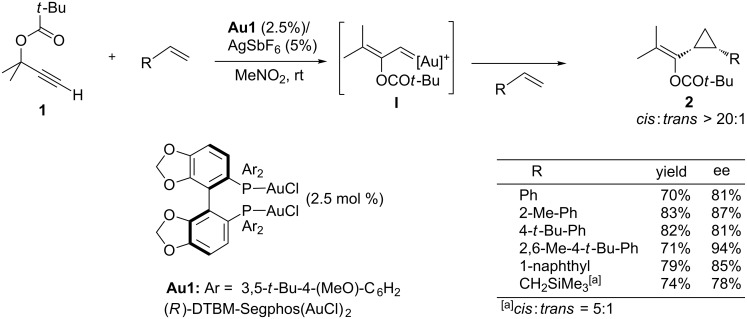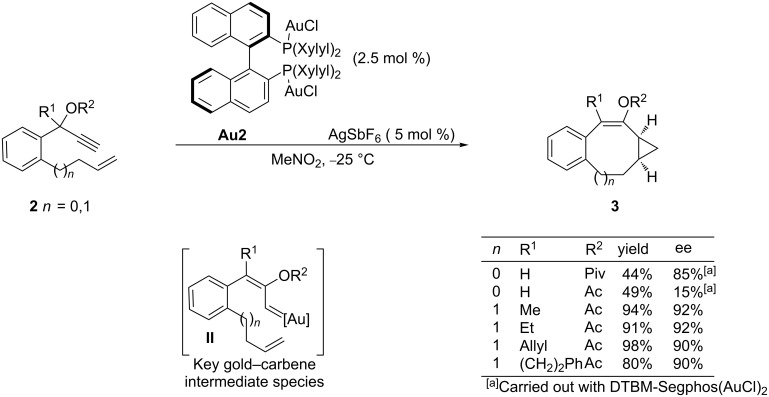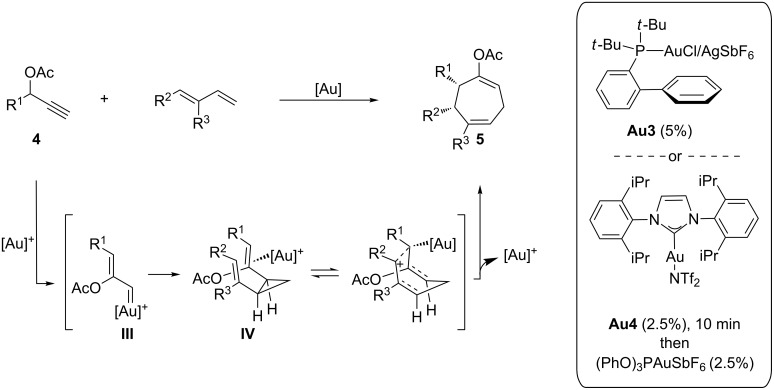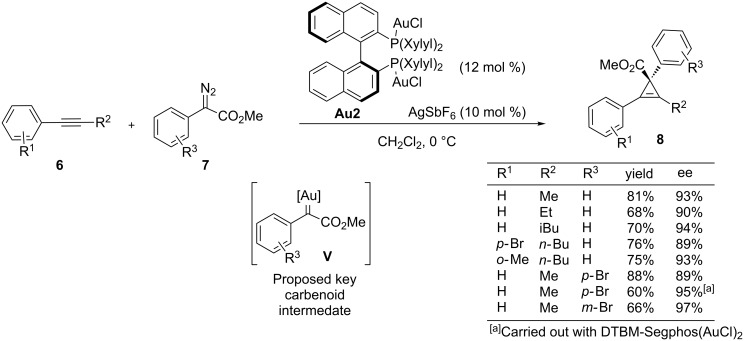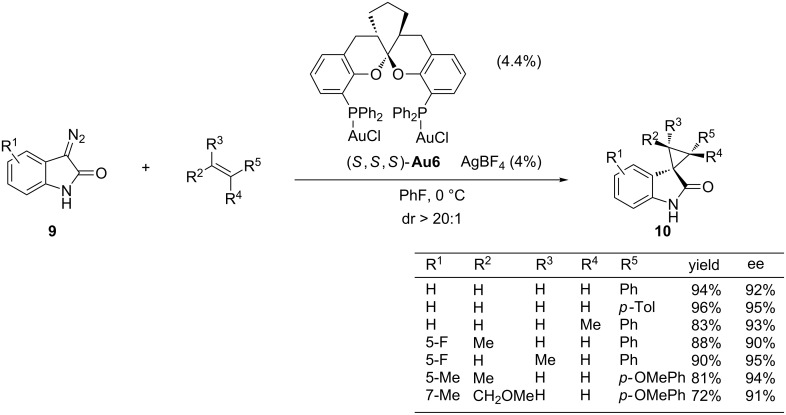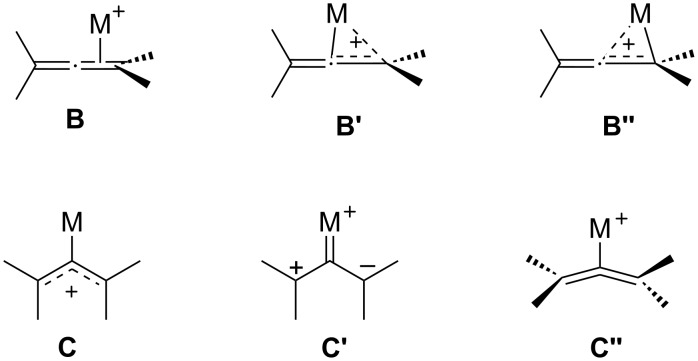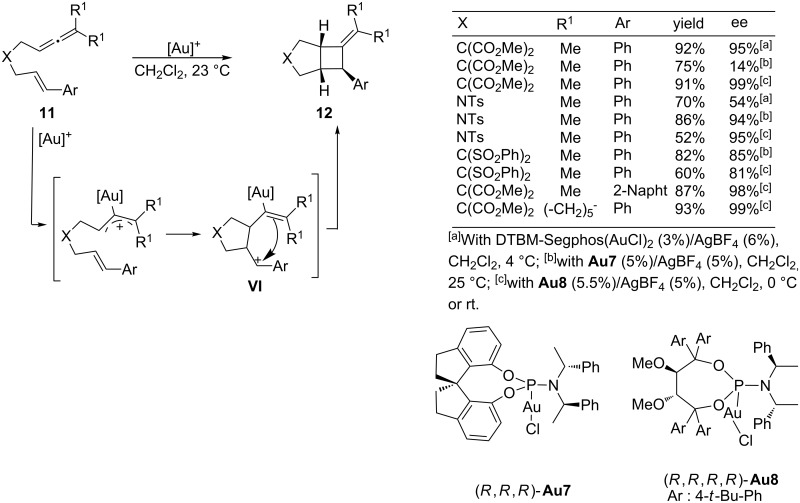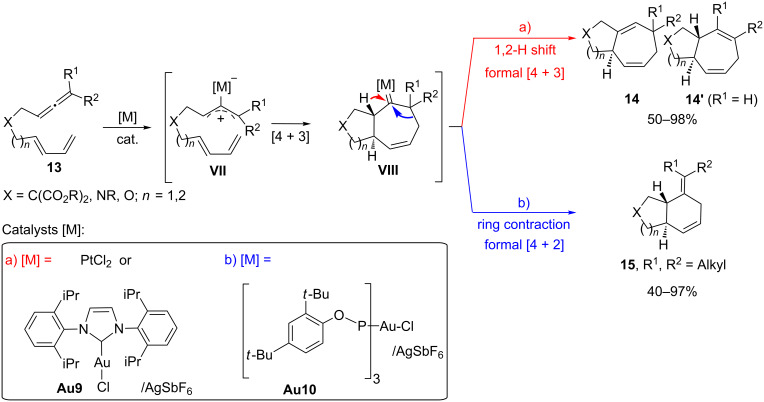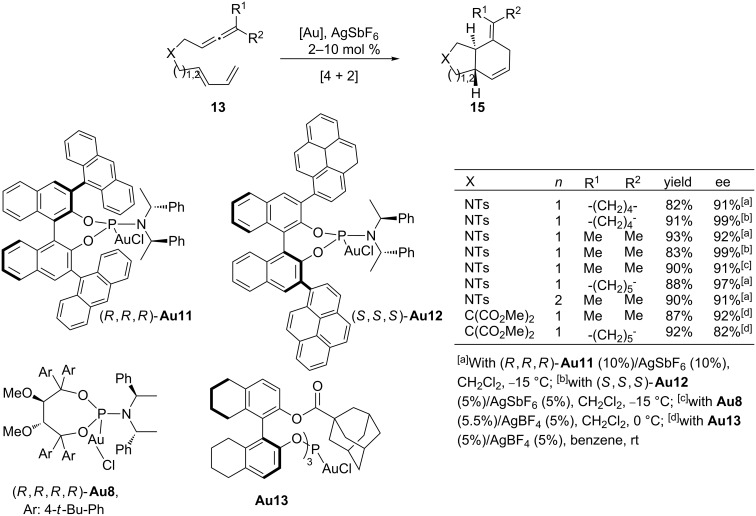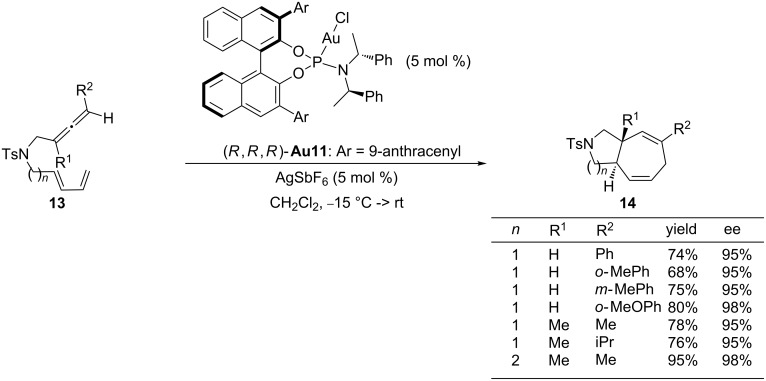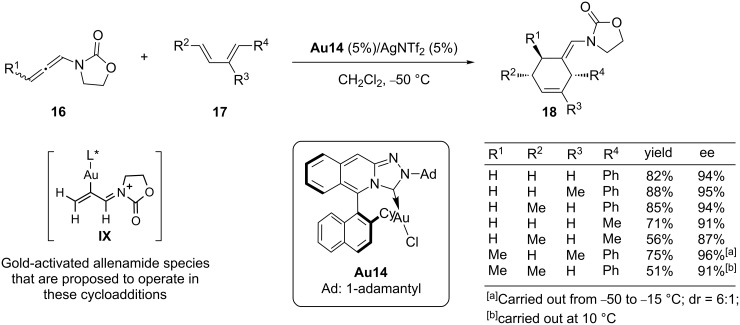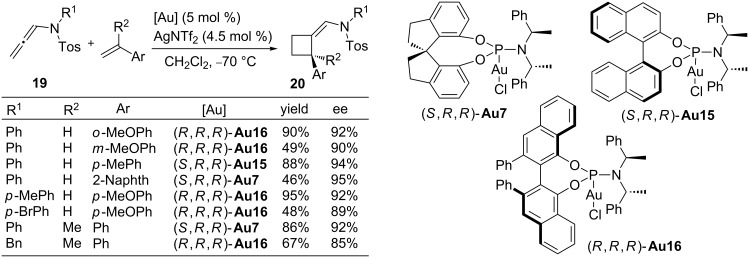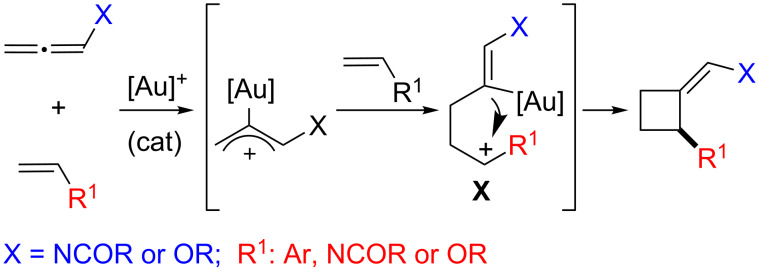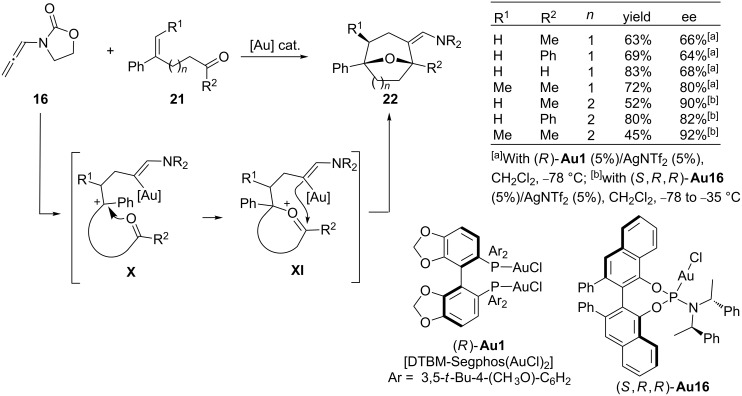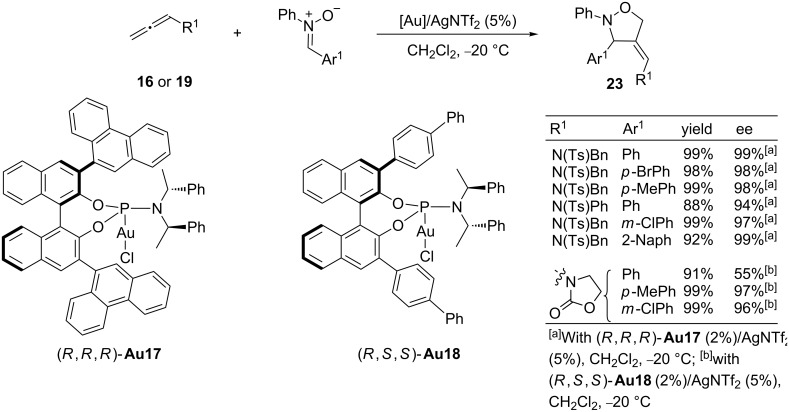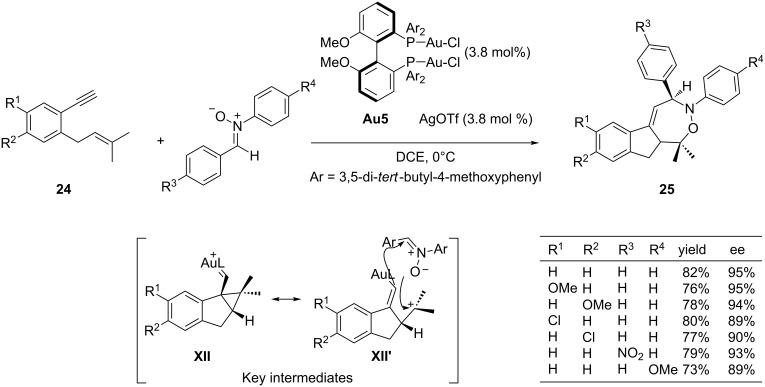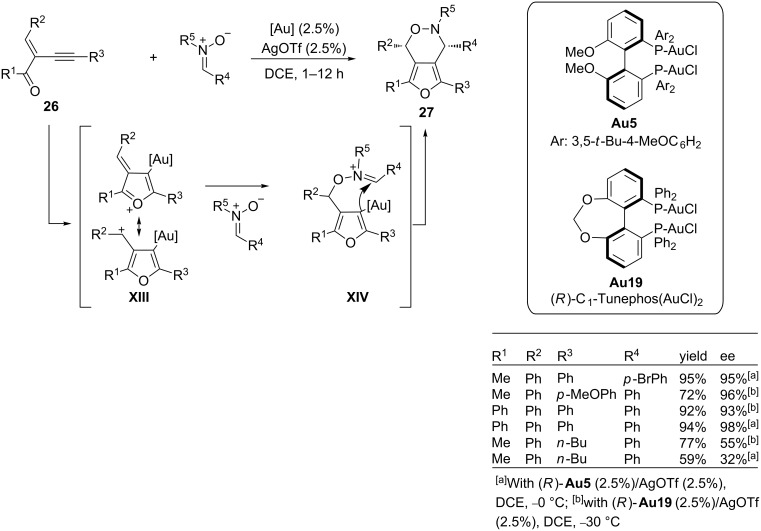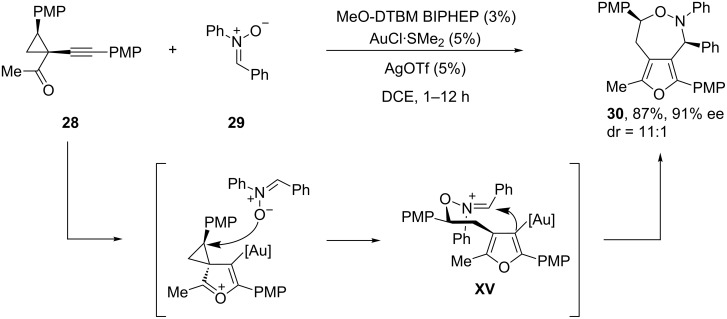Abstract
In recent years there have been extraordinary developments of gold(I)-catalyzed enantioselective processes. This includes progress in the area of cycloaddition reactions, which are of particular interest due to their potential for the rapid construction of optically active cyclic products. In this article we will summarize some of the most remarkable examples, emphasizing reaction mechanisms and key intermediates involved in the processes.
Keywords: alkyne, allene, asymmetric catalysis, cycloaddition, enantioselective, gold, gold catalysis
Introduction
In the past decade, there have been extraordinary advances in the development of novel stereoselective gold(I)-catalyzed transformations [1–10]. In this context, enantioselective gold catalysis has been identified as a particularly challenging goal because the linear two-coordination mode of gold(I) complexes and the out-sphere π-activation usually associated to carbophilic gold catalysts [11] places ligands far from the reacting centers, thus limiting the capacity to transfer asymmetry [12].
A number of strategies to tackle this problem have been developed, most of them based on the use of a new type of chiral gold complexes. This resulted in a number of gold-catalyzed enantioselective transformations in the past years, including hydrogenations, aldol reactions, 1,3-dipolar cycloadditions, and cyclizations [13–15]. Other gold-promoted asymmetric induction strategies rely on the use of chiral counterions. Indeed, it has been shown that a tight chiral ion pair with the gold cation is able to induce excellent levels of asymmetry in certain cyclizations [16].
Cycloaddition reactions are very important synthetic processes that allow the transformation of simple acyclic precursors into complex cyclic or polycyclic adducts in a rapid and efficient way [17–18], usually providing a rapid increase in skeletal and stereochemical complexity. Moreover, cycloadditions are atom economical, and usually take place with high levels of regio- and stereocontrol. Especially relevant in terms of synthetic practicality are cycloadditions which are catalyzed by transition metal complexes [19–23]. In particular, gold(I) complexes, owing to their high carbophilicity, low oxophilicity and high oxidation potential between gold(I) and gold(III) have shown a unique potential to unveil novel types of chemoselective and stereoselective cycloadditions involving alkynes, allenes or alkenes [24–26].
A lot of interest has been directed to the development of these cycloaddition processes in an enantioselective manner, so that the resulting cyclic products could be obtained in an optically pure fashion [27]. Herein, we describe the most relevant types of enantioselective cycloaddition reactions based on the use of carbophilic gold(I) complexes. We do not consider cycloaddition reactions in which the gold complex acts more like a conventional Lewis acid rather than by activating π-bonds [28–32]. The reactions included in this review are classified according to the type of key reactive gold intermediates that formally participate in the cycloaddition. Thus, we will present cycloaddition processes (i) with a gold–carbene intermediate, (ii) involving an allene activation to generate a gold–allyl cationic intermediate and, (iii) in which the proposed key reactant is a vinylgold zwitterionic species.
Review
Cycloadditions involving gold–carbene intermediates
Gold–carbene species are frequent intermediates in gold-catalyzed reactions, in particular those involving alkynes [33–37]. Gold(I) catalysts bind chemoselectively to C–C triple bonds, promoting the attack of different types of nucleophiles on these electrophilic species. Depending on the particular system, the resulting vinylgold intermediates can be externally trapped or evolve to reactive carbene species. This is the case for propargyl esters (Figure 1), as these systems usually undergo 1,2 or 1,3-acyloxy migrations in the presence of gold catalysts. Such migrations proceed via a nucleophilic intramolecular attack of the carboxy moiety on the activated alkyne. 1,2-Migration of the ester affording a gold–carbene of type A is usually preferred when a terminal alkyne is used [38–40].
Figure 1.
Gold-promoted 1,2-acyloxy migration on propargylic systems.
Based on this concept, several groups have shown that the resulting carbenoid intermediates of type A can engage in different types of cycloaddition reactions with diverse C–C unsaturated systems. Here, we discuss the systems for which an enantioselective variant has been developed.
In 2005, Toste and coworkers described one of the first gold-catalyzed enantioselective processes that could be formally categorized as a [2 + 1] cycloaddition. In particular, they showed that it is possible to trap the intermediate gold–carbenes resulting from a 1,2-acyloxy migration in propargyl esters such as 1, with external alkenes (e.g. vinylarenes), to give cyclopropane products [41]. The racemic variant of the method, which employs Ph3PAuCl/AgSbF6 as a catalyst, predominantly affords cis-cyclopropane adducts of type 2, and tolerates a wide range of olefin substituents. Importantly, the authors demonstrated that the process could also be rendered enantioselective by using a chiral bisgold complex derived from DTBM-Segphos (Au1). High or even very high levels of enantioselectivity could be achieved when the propargylic system features sterically demanding esters such as pivaloates, or the alkene component presents large aromatic substituents. In all these cases the reaction afforded the cis isomer with high diastereoselectivity. Moreover, the enantioselective cyclopropanation was not limited to arylated olefins (e.g. styrenes), but allyltrimethylsilane also participated in the process, producing the corresponding silylmethyl cyclopropane as a 5:1 mixture of cis:trans isomers with a good 78% ee (Scheme 1).
Scheme 1.
Gold-catalyzed enantioselective intermolecular cyclopropanation.
In 2009, the same group extended the utility of this asymmetric cyclopropanation reaction to an intramolecular process that allows the enantioselective synthesis of polycarbocyclic products embedding seven or eight-membered rings [42]. Curiously, the catalytic system based on DTBM-Segphos, which was particularly successful in the abovementioned intermolecular cases, only provided good enantioselectivities in the case of systems affording products with seven-membered rings (3, n = 0, Scheme 2). For the eight-membered counterparts, the authors found that a related bisphosphine–gold catalyst, Xylyl-Binap(AuCl)2/AgSbF6 was more efficient, facilitating good yields of the corresponding products and enantioselectivities between 75 and 92%. In these cases, the bulky pivaloate at the propargylic position led to lower enantioselectivites than a less congested acetate group, showcasing that a fine-tuning of the catalyst and substrate is required to achieve excellent enantioselectivities.
Scheme 2.
Gold-catalyzed enantioselective intramolecular cyclopropanation.
More recently, Nevado and co-workers have shown that propargyl acetates 4 react with 1,3-dienes in the presence of a gold catalyst to give good yields of cycloheptadiene products of type 5; thus the process could be formally considered as a [4 + 3] annulation. A possible mechanism would involve a gold-mediated 1,2-acyloxy migration of the propargyl ester to generate a gold–carbene species III which cyclopropanates a C–C double bond of the diene to form a cis-cyclopropane intermediate IV. A subsequent gold-catalyzed Cope rearrangement through a boat-like transition state would deliver the cis-2,3-disubstituted cycloheptenyl acetates of type 5 (Scheme 3) [43].
Scheme 3.
Gold-catalyzed cyclohepta-annulation cascade.
Although the process was essentially developed in a racemic fashion, by using Au3/AgSbF6 or a combination of Au4 and (PhO)3PAuSbF6 (Scheme 3), the authors also demonstrated the feasibility of an enantioselective variant. Thus, treatment of pivaloate 4a with 6,6-dimethyl-1-vinylcyclohexene in the presence of the chiral gold catalyst (S)-MeO-DTBM-Biphep(AuCl)2/AgSbF6, followed by in situ hydrolysis, allowed the construction of the basic bicarbocyclic core of frondosins (for example, 5a), in 68% yield and 90% ee (Scheme 4). Since this bicyclic enone was previously elaborated into frondosin A and B, the approach represented a streamlined formal enantioselective synthesis of both molecules.
Scheme 4.
Application to the formal synthesis of frondosin A.
Analogous to other transition metals from groups eight to eleven, gold has also demonstrated to be an efficient promoter of intermolecular carbene transfer reactions from diazo compounds to unsaturated systems such as alkenes or alkynes, resulting in cyclopropanation processes [44–45]. The development of an enantioselective variant of this type of reactions remained elusive until very recently, when Davies and co-workers reported a highly enantioselective cyclopropenation of internal alkynes 6 with aryldiazoacetates 7 [46]. In some cases the complex DTBM-Segphos(AuCl)2 (12%)/AgSbF6 (10%) provided the best performance. For most of the substrates, however, the chiral digold cationic complex XylylBinap(AuCl)2/AgSbF6 provided higher enantiomeric excesses and better yields of the desired cyclopropenes 8 (Scheme 5). The scope of the method encompasses a variety of aryl disubstituted alkynes 6 and several donor/acceptor aryldiazoacetates 7.
Scheme 5.
Gold(I)-catalyzed enantioselective cyclopropenation of alkynes.
In 2013, Zhou and co-workers reported another example of a highly enantioselective gold-catalyzed cyclopropanation reaction by using diazo compounds as a source of gold carbenes. In particular, the authors demonstrated that the chiral bisgold complex Au6, derived from the spiroketal bisphosphine ligand, was a very efficient promoter of the cyclopropanation between donor–acceptor diazooxindoles such as 9 and a broad range of alkenes (Scheme 6) [47]. The resulting spirocyclopropyloxindoles 10, which are obtained in excellent yields and enantioselectivities, are appealing structures from a medicinal point of view. The scope of the alkene is quite remarkable, since not only monosubstituted and 1,1-disubstituted olefins participated in the cyclopropanation, but also 1,2-disubstituted alkenes (cis or trans), which previously failed with other chiral transition metal catalysts, providing excellent yields and very good levels of enantioselectivity.
Scheme 6.
Enantioselective cyclopropanation of diazooxindoles.
Cycloadditions initiated by activation of allenes
Gold(I) catalysts can efficiently activate allenes in a highly chemoselective way, triggering the formation of allenyl cationic species. Different structures have been proposed to represent these gold-activated allene complexes, including η2-complexes (B, B’ and B’’), planar σ-allylic cations C, zwitterionic carbenes C’ or η1-bent allenes C’’ (Figure 2) [48]. In some cases, experimental and theoretical evidence supports the participation of one of those structures, but in many other cases the precise nature of these species remains unknown. The gold-activated allene complexes have been shown to participate in a great variety of intra- and intermolecular cycloaddition reactions, including [4 + 3], [4 + 2], [3 + 3], [3 + 2] or [2 + 2] annulation processes [1–10,24–26]. Particular attention has been paid during the last years to the development of enantioselective versions of these processes by using chiral gold catalysts. In this section, we highlight the most important developments in this area.
Figure 2.
Proposed structures for gold-activated allene complexes.
In 2007, Toste and coworkers described an intramolecular [2 + 2] cycloaddition of allenenes by using gold catalysts [49]. The proposed mechanism is based on the generation of a gold(I)-activated allene, which undergoes a cyclization to give a new carbocationic species of type VI (Scheme 7) [50–51]. A subsequent ring closure provides the observed bicyclo[3.2.0] systems of type 12, featuring a four-membered carbocycle. These reactions, which are efficiently promoted by Ph3PAu+BF4 in their racemic variants, could be performed in a highly enantioselective manner with gold catalysts containing a DTBM-Segphos ligand. Enantioselectivities ranged from 54 to 96%, and seem to be highly dependent on the tether that links the allene and the alkene moieties. Thus, the reaction proved to be efficient for substrates containing tethers with geminal diesters, whereas those containing N-tosyl-based tethers led to significantly lower enantioselectivities. However, the same group more recently demonstrated that a chiral phosphoramidite–gold complex, such as Au7, could eventually solve this limitation, leading to a complementary reactivity to that exhibited by DTBM-Segphos(AuCl)2/AgBF4 in terms of substrate scope, and affording enantioselectivities up to 97% (Scheme 6) [51]. Additionally, Fürstner and co-workers have also demonstrated that a phosphoramidite–gold complex like Au8, containing an acyclic Taddol-based backbone, was also an excellent catalyst to perform the same type of [2 + 2] cycloadditions of allenenes 11 [52–53]. This catalyst performs equally well with carbon-based and nitrogen-based tethers, and excellent levels of asymmetric induction were obtained from a set of representative examples, including those with structural modifications at the allene and alkene sites (Scheme 7).
Scheme 7.
Gold-catalyzed enantioselective [2 + 2] cycloadditions of allenenes.
Early in 2008, our group demonstrated the possibility of using gold-activated allenes as allyl cation surrogates capable of participating in concerted [4C(4π) + 3C(2π)] cycloadditions with conjugated dienes [54], a process related to the classical oxyallyl cation [4 + 3] cycloadditions [55–57]. An initial screening demonstrated that PtCl2 was a good catalyst for promoting these intramolecular [4C + 3C] cycloadditions [54]. Further studies revealed that the scope of the methodology could be significantly broadened by using a gold catalyst such as Au9/AgSbF6 [58]. In general, the reactions are completely diastereoselective, affording bicyclo[5.3.0]decane products (14 and/or 14’) that result from an exo-like approach of the allyl cation to the diene. Curiously, by using a gold(I) catalyst bearing a π-acceptor phosphite ligand, such as Au10/AgSbF6, allenedienes disubstituted at the distal position of the allene lead to products formally arising from a [4 + 2] cycloaddition process (Scheme 8, b) [59–60]. Several experimental data as well as theoretical calculations suggested that both cycloadducts, 14 and 15, arise from the same intermediate, the cycloheptanyl metal–carbene species VIII, which might evolve through a 1,2-hydrogen shift to give the seven-membered carbocycles 14 (Scheme 8, a), or by a ring-contraction process to give the cyclohexenyl products (Scheme 8, b) [60–64]. Therefore, the ligand at gold, as well as the type of substituents at the allene terminus, determine the fate of this carbene and hence the formation of the [4 + 3] (14) or [4 + 2] (15) cycloadducts.
Scheme 8.
Gold-catalyzed allenediene [4 + 3] and [4 + 2] cycloadditions.
The development of enantioselective versions of these two cycloadditions was actively pursued by several groups. The electronic similarity between phosphites and phosphoramidites suggested that chiral gold complexes of these highly modular monodentate ligands [65] could be good candidates to promote enantioselective variants of the [4 + 2] cycloaddition (Scheme 9, R1, R2 = alkyl groups). This turned out to be the case and, gratifyingly, we showed that it is possible to perform highly enantioselective allenediene [4 + 2] cycloadditions by using gold complexes derived from a bulky phosphoramidite equipped with anthracenyl substituents at the Binol ortho-positions (Au11, Scheme 9) [60]. Independently, Toste and co-workers reported that the related phosphoramidite–gold complex Au12, and the chiral gold catalyst Au13, derived from a C3-symmetric phosphite [66], were also able to induce excellent enantioselectivities in these [4 + 2] cycloadditions [67]. Moreover, Fürstner and co-workers also showed that the Taddol-based phosphoramidite–gold complex Au8, which was effective in the [2 + 2] cycloadditions of allenenes, was also able to induce good enantioselectivities in these higher order annulations (Scheme 9) [52].
Scheme 9.
Gold-catalyzed enantioselective [4 + 2] cycloadditions of allenedienes.
Although π-acceptor ligands, such as phosphites or phosphoramidites favor the formation of the [4 + 2] adduct of type 15, DFT calculations indicated that the activation barriers for the ring-contraction process leading to these six-membered systems, and the 1,2-H shifts that retain that seven-membered ring, are quite similar [60]. Therefore, it seemed plausible that this type of chiral catalysts could also provide an enantioselective entry to the seven-membered adducts of type 14, provided that the ring-contraction route could be slightly deactivated. The viability of this hypothesis was validated by Mascareñas, López and co-workers, demonstrating that terminally monosubstituted allenes, which provide carbene intermediates that are less prone to undergo a ring contraction (VIII, Scheme 8), react with phosphoramidite–gold catalyst Au11/AgSbF6 to afford optically active, synthetically relevant bicyclo[5.3.0]decadiene and bicyclo[5.4.0]undecadiene skeletons 14 with good yields, complete diastereocontrol and excellent enantioselectivities (Scheme 10) [68]. The scope of this method, which constituted the first highly enantioselective intramolecular [4C + 3C] cycloaddition promoted by a transition metal complex, encompasses internally monosubstituted allenes, as well as disubstituted counterparts, offering a direct entry to 5,7 bicyclic systems including those with all-carbon quaternary stereocenters at the ring fusion.
Scheme 10.
Gold-catalyzed enantioselective [4 + 3] cycloadditions of allenedienes.
In contrast to the intramolecular counterpart, gold-catalyzed intermolecular cycloadditions of allenes have been scarcely studied. However, significant progress has been made in the last 4 years. While the development of an intermolecular [4 + 3] cycloaddition between allenes and dienes remains elusive, neither in a racemic nor enantioselective fashion [69], it has been shown that allenamides [70] or allenyl ethers [71] participate as two-carbon atom components in several gold-catalyzed [4 + 2] cycloadditions with dienes. The racemic version of the reaction between allenamides and dienes, which is efficiently promoted by AuCl or the cationic gold catalyst Au9/AgSbF6, was translated into a enantioselective version by using a novel chiral gold complex Au14, featuring a triazole unit embedded in a rigid axially chiral cyclic frame (Scheme 11) [72]. The catalyst generated from Au14 and AgNTf2 was able to promote the [4 + 2] cycloaddition between allenamides 16 and conjugated dienes 17 with total regio- and stereoselectivity and excellent enantioselectivity. The method provides a versatile and practical approach to a variety of optically active cyclohexene products like 18. Importantly, the scope of the asymmetric process is even wider than that of the racemic reaction [70], allowing the construction of six-membered adducts with up to three new stereogenic centers with complete diastereoselectivity and enantioselectivities of up to 91% ee (R1, R2 = Me, R4 = Ph, Scheme 11). With regard to the mechanism, it has been proposed that the activation of the allenamide by the gold catalyst provides a gold–allyl cationic species of type IX, which is the species undergoing the cycloaddition process with the diene [73].
Scheme 11.
Gold-catalyzed enantioselective [4 + 2] cycloadditions of allenamides.
Simple alkenes do also react with gold-activated allenamides to provide cyclobutane products, formally resulting from a [2 + 2] cycloaddition. Thus, independent investigations by the groups of Mascareñas, González and Chen revealed that the gold-catalyzed cycloaddition between an allenamide and an appropriate alkene (e.g., enamide, enol ether or vinylarene) provides a variety of cyclobutanic systems in excellent yields. The optimum catalysts for the racemic processes include a phosphite–gold complex Au10 and a biaryldi-tert-butylphosphine–gold complex (Au3) [74–76]. More recently, González and co-workers accomplished the enantioselective version of these annulations between sulfonyl allenamides and vinylarenes, providing a straightforward entry into optically active cyclobutanes [77]. Several chiral phosphoramidite–gold complexes, such as (S,R,R)-Au7, (S,R,R)-Au15 and (R,R,R)-Au16, derived from Siphos, Binol and Vanol, respectively, provided excellent enantioselectivities, displaying useful complementarity in some of the cases. Importantly, the method also allowed the preparation of cyclobutanes 20 containing challenging quaternary carbon centers (Scheme 12).
Scheme 12.
Enantioselective [2 + 2] cycloadditions of allenamides.
From a mechanistic point of view, these [2 + 2] cycloadditions, either in racemic or asymmetric versions, have been proposed to proceed through a stepwise cationic pathway consisting of an initial activation of the allene to provide an Au–allyl cationic species, followed by a regioselective interception by the alkene to give a second cationic intermediate (X, Scheme 13) [73]. The substituent at the alkene (R1, Scheme 13), either an aryl, nitrogen or oxygen-group, plays a key role in the stabilization of this intermediate and therefore facilitates the overall process. Finally, a ring-closing process through attack of the vinylgold species to the stabilized carbocation yields the cyclobutane system and regenerates the catalyst.
Scheme 13.
Mechanistic rational for the gold-catalyzed [2 + 2] cycloadditions.
In view of this mechanistic proposal, Mascareñas and López recently developed a gold-catalyzed cascade cycloaddition between allenamides and carbonyl-tethered alkenes 21, including an enantioselective variant, that provides synthetically appealing oxa-bridged seven, eight and even nine-membered rings (22, Scheme 14) [78]. The cascade process relies on the interception of intermediates of type X by an intramolecular carbonyl group, followed by the ring closing of the resulting oxonium intermediate XI. The reaction occurs at low temperatures by using only 1 mol % of a phosphite-based gold catalyst. The enantioselective version, which is catalyzed by the DTBM-Segphos complex Au1/AgNTf2, or the phosphoramidite–gold complex (S,R,R)-Au16/AgNTf2, provides the corresponding cycloadducts 22 with good or high enantioselectivites (Scheme 14). The method constituted the first direct catalytic and enantioselective entry to oxygen-bridged eight-membered carbocycles and one of the few methods that affords optically active cyclooctanes by means of a catalytic enantioselective process.
Scheme 14.
Enantioselective cascade cycloadditions between allenamides and oxoalkenes.
Also recently, Chen and co-workers demonstrated that gold-activated allenamide species can participate in [3 + 2] cycloadditions with azomethine imines or nitrones under catalysis with Ph3PAuCl/AgOTf or Ph3PAuCl/AgNTf2 [79–80]. Moreover, for the latter cycloaddition with nitrones, the authors reported a enantioselective variant by using chiral phosphoramidite–gold complexes. In these cases, the binol-derived complexes, with aryl substituents at the 3 and 3’ positions, turned out to be the optimal systems, providing the corresponding 4-alkylidenylisoxazolidine derivatives 23 in high yields and excellent enantioselectivities. The highest enantioselectivities were obtained with (R,R,R)-Au17 and (R,S,S)-Au18, which include 9-phenantrenyl or 4-biphenyl units in these binol ortho-positions, respectively (Scheme 15). Further derivatization of the products led to enantio-enriched 1,3-aminoalcohols.
Scheme 15.
Enantioselective [3 + 2] cycloadditions of nitrones and allenamides.
Other reactions involving zwitterionic alkenylgold intermediates
The gold-bound allyl cation species generated from allenes could be formally viewed as 1,2 or 1,3-zwitterionic cycloaddition components. In a recent paper, Liu and co-workers demonstrated that 1,6-enynes like 24 when treated with appropriated gold complexes lead to related 1,4-zwitterionic homologs that can be efficiently intercepted by nitrones in a formal [4 + 3] cycloaddition reaction. The resulting 1,2-oxazepane derivatives 25 are isolated as single diastereoisomers with high enantioselectivities (84–95% ee) [81]. Optimal conditions for the enantioselective variant of the process involved the use of the chiral gold complex Au5 (3.8 mol %), derived from MeO-DTBM-Biphep, in combination with AgOTf. The requirement of equimolar amounts of the silver salt and the bisgold complex suggests that only one Au–Cl bond remains intact in the gold catalyst (Scheme 16). From a mechanistic point of view, the authors proposed that the intermediate species can be viewed as either a cyclopropylgold carbenoid XII or as a zwitterionic alkenylgold derivative XII’, the latter being the species that participates in the cycloaddition to the nitrone, probably in a concerted pathway, and thus providing the corresponding products with high levels of stereoselectivity [82–83].
Scheme 16.
Enantioselective formal [4 + 3] cycloadditions leading to 1,2-oxazepane derivatives.
Previously, in 2009, J. Zhang had reported a gold(I)-catalyzed 1,3-dipolar [3 + 3] cycloaddition between 2-(1-alkynyl)-2-alken-1-ones 26 and nitrones. The reactions provide fused heterobicyclic oxazine derivatives of type 27 with good yields and excellent regio- and diastereoselectivities. The racemic series, promoted by Ph3PAuCl/AgOTf as a catalyst [84], was translated into an enantioselective version by using any of the chiral bisgold complexes derived from (R)-C1-Tunephos (Au19) or (R)-MeO-DTBM-Biphep (Au5) (Scheme 17) [85]. From a mechanistic point of view, the authors proposed the generation of a zwitterionic furanylgold complex of type XIII by a gold-promoted intramolecular cyclization process. This key intermediate is then trapped by the nitrone to afford XIV, which eventually evolves to the product by an intramolecular cyclization (Scheme 17).
Scheme 17.
Enantioselective gold(I)-catalyzed 1,3-dipolar [3 + 3] cycloaddition between 2-(1-alkynyl)-2-alken-1-ones and nitrones.
Finally, the same group recently reported a related reaction of 1-(1-alkynyl)cyclopropyl ketones such as 28, by means of a gold(I)-catalyzed asymmetric [4 + 3] cycloaddition. In this article, the authors demonstrated that a chiral gold catalyst generated from MeO-DTBM-Biphep was able to promote the [4 + 3] cycloaddition between ketone 28 and the nitrone 29, to afford the corresponding 5,7-fused bicyclic furo[3,4-d][1,2]oxazepine 30 in good yield, high diastereoselectivity (dr 11:1) and excellent 91% ee (Scheme 18) [86–88]. However, the extension of this method to 1-(1-alkynyl)cyclopropyl ketones and nitrones others than 28 and 29 remains to be demonstrated.
Scheme 18.
Enantioselective [4 + 3] cycloaddition leading to 5,7-fused bicyclic furo[3,4-d][1,2]oxazepines.
Conclusion
In the last years there have been remarkable advances in the development of enantioselective gold(I)-catalyzed cycloadditions. Although the area is still in its infancy, there is enough evidence to predict that the number of examples will steadily increase in the near future. It would be highly desirable to have more information on the precise factors that govern the enantioselectivity process, as this will facilitate the design of new asymmetric processes.
Acknowledgments
Our work in the area is supported by the Spanish MINECO [SAF2010-20822-c02-01/02, and Consolider-Ingenio 2010 (CSD2007-00006)], CSIC and Xunta de Galicia (GRC2010/12, INCITE09 209 122 PR, GRC2013-041), as well as the ERDF.
This article is part of the Thematic Series "Gold catalysis for organic synthesis II".
Contributor Information
Fernando López, Email: fernando.lopez@csic.es.
José L Mascareñas, Email: joseluis.mascarenas@usc.es.
References
- 1.Hashmi A S K, Toste F D, editors. Modern Gold Catalyzed Synthesis. Weinheim, Germany: Wiley–VCH; 2012. [Google Scholar]
- 2.Rudolph M, Hashmi A S K. Chem Soc Rev. 2012;41:2448. doi: 10.1039/c1cs15279c. [DOI] [PubMed] [Google Scholar]
- 3.Liu L-P, Hammond G B. Chem Soc Rev. 2012;41:3129. doi: 10.1039/c2cs15318a. [DOI] [PubMed] [Google Scholar]
- 4.Krause N, Winter C. Chem Rev. 2011;111:1994. doi: 10.1021/cr1004088. [DOI] [PubMed] [Google Scholar]
- 5.Corma A, Leyva-Perez A, Sabater M J. Chem Rev. 2011;111:1657. doi: 10.1021/cr100414u. [DOI] [PubMed] [Google Scholar]
- 6.Abu Sohel S Md, Liu R-S. Chem Soc Rev. 2009;38:2269. doi: 10.1039/b807499m. [DOI] [PubMed] [Google Scholar]
- 7.Gorin D J, Sherry B D, Toste F D. Chem Rev. 2008;108:3351. doi: 10.1021/cr068430g. [DOI] [PMC free article] [PubMed] [Google Scholar]
- 8.Jiménez-Núñez E, Echavarren A M. Chem Rev. 2008;108:3326. doi: 10.1021/cr0684319. [DOI] [PubMed] [Google Scholar]
- 9.Arcadi A. Chem Rev. 2008;108:3266. doi: 10.1021/cr068435d. [DOI] [PubMed] [Google Scholar]
- 10.Hashmi A S K. Chem Rev. 2007;107:3180. doi: 10.1021/cr000436x. [DOI] [PubMed] [Google Scholar]
- 11.Widenhoefer R A. Chem–Eur J. 2008;14:5382. doi: 10.1002/chem.200800219. [DOI] [PubMed] [Google Scholar]
- 12.Gorin D J, Toste F D. Nature. 2007;446:395. doi: 10.1038/nature05592. [DOI] [PubMed] [Google Scholar]
- 13.Sengupta S, Shi X. ChemCatChem. 2010;2:609. doi: 10.1002/cctc.201000070. [DOI] [Google Scholar]
- 14.Pradal A, Toullec P Y, Michelet V. Synthesis. 2011:1501. doi: 10.1055/s-0030-1258465. [DOI] [Google Scholar]
- 15.Muñoz M P, Adrio J, Carretero J C, Echavarren A M. Organometallics. 2005;24:1293. doi: 10.1021/om0491645. See for the pioneer development of new chiral carbophilic gold complexes. [DOI] [Google Scholar]
- 16.Hamilton G L, Kang E J, Mba M, Toste F D. Science. 2007;317:496. doi: 10.1126/science.1145229. [DOI] [PubMed] [Google Scholar]
- 17.Carruthers W. Cycloaddition Reactions in Organic Synthesis. Oxford: Pergamon; 1990. [Google Scholar]
- 18.Kobayashi S, Jorgensen K A. Cycloaddition Reactions in Organic Synthesis. Weinheim, Germany: Wiley-VCH; 2002. [Google Scholar]
- 19.Lautens M, Klute W, Tam W. Chem Rev. 1996;96:49. doi: 10.1021/cr950016l. [DOI] [PubMed] [Google Scholar]
- 20.Pellissier H. Adv Synth Catal. 2011;353:189. doi: 10.1002/adsc.201000695. [DOI] [Google Scholar]
- 21.Butenschön H. Angew Chem, Int Ed. 2008;47:5287. doi: 10.1002/anie.200801738. [DOI] [PubMed] [Google Scholar]
- 22.Gulias M, López F, Mascareñas J L. Pure Appl Chem. 2011;83:495. doi: 10.1351/PAC-CON-10-10-23. [DOI] [Google Scholar]
- 23.Inglesby P A, Evans P A. Chem Soc Rev. 2010;39:2791. doi: 10.1039/b913110h. [DOI] [PubMed] [Google Scholar]
- 24.López F, Mascareñas J L. Beilstein J Org Chem. 2011;7:1075. doi: 10.3762/bjoc.7.124. [DOI] [PMC free article] [PubMed] [Google Scholar]
- 25.Shen H C. Tetrahedron. 2008;64:7847. doi: 10.1016/j.tet.2008.05.082. [DOI] [Google Scholar]
- 26.Garayalde D, Nevado C. ACS Catal. 2012;2:1462. doi: 10.1021/cs300043w. [DOI] [Google Scholar]
- 27.Marinetti A, Jullien H, Voituriez A. Chem Soc Rev. 2012;41:4884. doi: 10.1039/c2cs35020c. See for a review covering transition metal catalyzed enantioselective cycloadditions. [DOI] [PubMed] [Google Scholar]
- 28.Melhado A D, Amarante G W, Wang Z J, Luparia M, Toste F D. J Am Chem Soc. 2011;133:3517. doi: 10.1021/ja1095045. [DOI] [PMC free article] [PubMed] [Google Scholar]
- 29.Melhado A D, Luparia M, Toste F D. J Am Chem Soc. 2007;129:12638. doi: 10.1021/ja074824t. [DOI] [PubMed] [Google Scholar]
- 30.Martín-Rodríguez M, Nájera C, Sansano J M, Wu F-L. Tetrahedron: Asymmetry. 2010;21:1184. doi: 10.1016/j.tetasy.2010.06.011. [DOI] [Google Scholar]
- 31.Martín-Rodríguez M, Nájera C, Sansano J M, de Cózar A, Cossío F P. Beilstein J Org Chem. 2011;7:988. doi: 10.3762/bjoc.7.111. [DOI] [PMC free article] [PubMed] [Google Scholar]
- 32.Liu B, Li K-N, Luo S-W, Huang J-Z, Pang H, Gong L-Z. J Am Chem Soc. 2013;135:3323. doi: 10.1021/ja3110472. [DOI] [PubMed] [Google Scholar]
- 33.Benitez D, Shapiro N D, Tkatchouk N, Wang Y, Goddard W A, III, Toste F D. Nat Chem. 2009;1:482. doi: 10.1038/nchem.331. Many Au-carbene species can also be understood as Au-stabilized carbocations. [DOI] [PMC free article] [PubMed] [Google Scholar]
- 34.Seidel G, Mynott R, Fürstner A. Angew Chem, Int Ed. 2009;48:2510. doi: 10.1002/anie.200806059. [DOI] [PubMed] [Google Scholar]
- 35.Fürstner A, Morency L. Angew Chem, Int Ed. 2008;47:5030. doi: 10.1002/anie.200800934. [DOI] [PubMed] [Google Scholar]
- 36.Nieto-Oberhuber C, Muñoz M P, Buñuel E, Nevado C, Cárdenas D J, Echavarren A M. Angew Chem, Int Ed. 2004;43:2402. doi: 10.1002/anie.200353207. [DOI] [PubMed] [Google Scholar]
- 37.Echavarren A. Nat Chem. 2009;1:431. doi: 10.1038/nchem.344. [DOI] [PubMed] [Google Scholar]
- 38.Correa A, Marion N, Fensterbank L, Malacria M, Nolan S P, Cavallo L. Angew Chem, Int Ed. 2008;47:718. doi: 10.1002/anie.200703769. [DOI] [PubMed] [Google Scholar]
- 39.Marion N, Nolan S P. Angew Chem, Int Ed. 2007;46:2750. doi: 10.1002/anie.200604773. [DOI] [PubMed] [Google Scholar]
- 40.Marco-Contelles J, Soriano E. Chem–Eur J. 2007;13:1350. doi: 10.1002/chem.200601522. [DOI] [PubMed] [Google Scholar]
- 41.Johansson M J, Gorin D J, Staben S T, Toste F D. J Am Chem Soc. 2005;127:18002. doi: 10.1021/ja0552500. [DOI] [PubMed] [Google Scholar]
- 42.Watson I D G, Ritter S, Toste F D. J Am Chem Soc. 2009;131:2056. doi: 10.1021/ja8085005. [DOI] [PMC free article] [PubMed] [Google Scholar]
- 43.Garayalde D, Krüger K, Nevado C. Angew Chem, Int Ed. 2011;50:911. doi: 10.1002/anie.201006105. [DOI] [PubMed] [Google Scholar]
- 44.Fructos M R, Belderrain T R, de Fremont P, Scott N M, Nolan S P, Díaz-Requejo M M, Pérez P J. Angew Chem, Int Ed. 2005;44:5284. doi: 10.1002/anie.200501056. [DOI] [PubMed] [Google Scholar]
- 45.Prieto A, Fructos M R, Díaz-Requejo M M, Pérez P J, Pérez-Galán P, Delpont N, Echavarren A M. Tetrahedron. 2009;65:1790. doi: 10.1016/j.tet.2008.10.114. [DOI] [Google Scholar]
- 46.Briones J F, Davies H M L. J Am Chem Soc. 2012;134:11916. doi: 10.1021/ja304506g. [DOI] [PubMed] [Google Scholar]
- 47.Cao Z-Y, Wang X, Tan C, Zhao X-L, Zhou J, Ding K. J Am Chem Soc. 2013;135:8197. doi: 10.1021/ja4040895. [DOI] [PubMed] [Google Scholar]
- 48.Gandon V, Lemière G, Hours A, Fensterbank L, Malacria M. Angew Chem, Int Ed. 2008;47:7534. doi: 10.1002/anie.200802332. [DOI] [PubMed] [Google Scholar]
- 49.Luzung M R, Mauleón P, Toste F D. J Am Chem Soc. 2007;129:12402. doi: 10.1021/ja075412n. [DOI] [PubMed] [Google Scholar]
-
50.Recent theoretical computations indicate that the intermediate of type VI, could be better described as VI', where the gold center establishes a stabilizing electrostatic interaction with the benzylic carbocation. See reference [51].
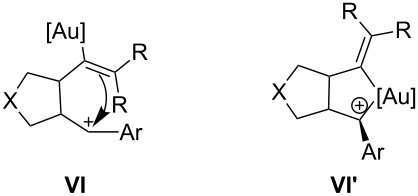
- 51.González A Z, Benitez D, Tkatchouk E, Goddard W A, Toste F D. J Am Chem Soc. 2011;133:5500. doi: 10.1021/ja200084a. [DOI] [PMC free article] [PubMed] [Google Scholar]
- 52.Teller H, Flügge S, Goddard R, Fürstner A. Angew Chem, Int Ed. 2010;49:1949. doi: 10.1002/anie.200906550. [DOI] [PubMed] [Google Scholar]
- 53.Teller H, Corbet M, Mantilli L, Gopakumar G, Goddard R, Thiel W, Fürstner A. J Am Chem Soc. 2012;134:15331. doi: 10.1021/ja303641p. [DOI] [PubMed] [Google Scholar]
- 54.Trillo B, López F, Gulías M, Castedo L, Mascareñas J L. Angew Chem, Int Ed. 2008;47:951. doi: 10.1002/anie.200704566. [DOI] [PubMed] [Google Scholar]
- 55.Harmata M. Chem Commun. 2010;46:8904. doi: 10.1039/c0cc03621h. [DOI] [PubMed] [Google Scholar]
- 56.Harmata M. Chem Commun. 2010;46:8886. doi: 10.1039/c0cc03620j. [DOI] [PubMed] [Google Scholar]
- 57.Fernández I, Cossío F P, de Cózar A, Lledós A, Mascareñas J L. Chem–Eur J. 2010;16:12147. doi: 10.1002/chem.201001714. [DOI] [PubMed] [Google Scholar]
- 58.Trillo B, López F, Montserrat S, Ujaque G, Castedo L, Lledós A, Mascareñas J L. Chem–Eur J. 2009;15:3336. doi: 10.1002/chem.200900164. [DOI] [PubMed] [Google Scholar]
- 59.Mauleón P, Zeldin R M, González A Z, Toste F D. J Am Chem Soc. 2009;131:6348. doi: 10.1021/ja901649s. [DOI] [PMC free article] [PubMed] [Google Scholar]
- 60.Alonso I, Trillo B, López F, Montserrat S, Ujaque G, Castedo L, Lledós A, Mascareñas J L. J Am Chem Soc. 2009;131:13020. doi: 10.1021/ja905415r. [DOI] [PubMed] [Google Scholar]
- 61.Montserrat S, Alonso I, López F, Mascareñas J L, Lledós A, Ujaque G. Dalton Trans. 2011;40:11095. doi: 10.1039/c1dt11061f. [DOI] [PubMed] [Google Scholar]
- 62.Montserrat S, Ujaque G, López F, Mascareñas J L, Lledós A. Top Curr Chem. 2011;302:225. doi: 10.1007/128_2010_121. [DOI] [PubMed] [Google Scholar]
- 63.Benitez D, Tkatchouk E, Gonzalez A Z, Goddard W A, III, Toste F D. Org Lett. 2009;11:4798. doi: 10.1021/ol9018002. [DOI] [PMC free article] [PubMed] [Google Scholar]
- 64.Fernández I, Mascareñas J L. Org Biomol Chem. 2012;10:699. doi: 10.1039/c1ob06604h. [DOI] [PubMed] [Google Scholar]
- 65.Teichert J F, Feringa B L. Angew Chem, Int Ed. 2010;49:2486. doi: 10.1002/anie.200904948. [DOI] [PubMed] [Google Scholar]
- 66.Reetz M T, Guo H, Ma J-A, Goddard R, Mynott R J. J Am Chem Soc. 2009;131:4136. doi: 10.1021/ja809297a. [DOI] [PubMed] [Google Scholar]
- 67.González A Z, Toste F D. Org Lett. 2010;12:200. doi: 10.1021/ol902622b. [DOI] [PMC free article] [PubMed] [Google Scholar]
- 68.Alonso I, Faustino H, López F, Mascareñas J L. Angew Chem, Int Ed. 2011;50:11496. doi: 10.1002/anie.201105815. [DOI] [PubMed] [Google Scholar]
- 69.Gung B W, Bailey L N, Wonser J. Tetrahedron Lett. 2010;51:2251. doi: 10.1016/j.tetlet.2010.02.099. [DOI] [PMC free article] [PubMed] [Google Scholar]
- 70.Faustino H, López F, Castedo L, Mascareñas J L. Chem Sci. 2011;2:633. doi: 10.1039/c0sc00630k. [DOI] [Google Scholar]
- 71.Wang G, Zou Y, Li Z, Wang Q, Goeke A. Adv Synth Catal. 2011;353:550. doi: 10.1002/adsc.201000597. [DOI] [Google Scholar]
- 72.Francos J, Grande-Carmona F, Faustino H, Iglesias-Siguenza J, Díez E, Alonso I, Fernández R, Lassaletta J M, López F, Mascareñas J L. J Am Chem Soc. 2012;134:14322. doi: 10.1021/ja3065446. [DOI] [PubMed] [Google Scholar]
- 73.Montserrat S, Faustino H, Lledós A, Mascareñas J L, López F, Ujaque G. Chem–Eur J. 2013;19:15248. doi: 10.1002/chem.201302330. [DOI] [PubMed] [Google Scholar]
- 74.Faustino H, Bernal P, Castedo L, López F, Mascareñas J L. Adv Synth Catal. 2012;354:1658. doi: 10.1002/adsc.201200047. [DOI] [Google Scholar]
- 75.Suárez-Pantiga S, Hernández-Díaz C, Piedrafita M, Rubio E, González J M. Adv Synth Catal. 2012;354:1651. doi: 10.1002/adsc.201200043. [DOI] [Google Scholar]
- 76.Li X-X, Zhu L-L, Zhou W, Chen Z. Org Lett. 2012;14:436. doi: 10.1021/ol202703a. [DOI] [PubMed] [Google Scholar]
- 77.Suárez-Pantiga S, Hernández-Diaz C, Rubio E, González J M. Angew Chem, Int Ed. 2012;51:11552. doi: 10.1002/anie.201206461. [DOI] [PubMed] [Google Scholar]
- 78.Faustino H, Alonso I, Mascareñas J L, López F. Angew Chem, Int Ed. 2013;52:6526. doi: 10.1002/anie.201302713. [DOI] [PubMed] [Google Scholar]
- 79.Zhou W, Li X-X, Li G-H, Wu Y, Chen Z. Chem Commun. 2013;49:3552. doi: 10.1039/c3cc41258j. [DOI] [PubMed] [Google Scholar]
- 80.Li G-H, Zhou W, Li X-X, Bi Q-W, Wang Z, Zhao Z-G, Hu W-X, Chen Z. Chem Commun. 2013;49:4770. doi: 10.1039/c3cc41769g. [DOI] [PubMed] [Google Scholar]
- 81.Gawade S A, Bhunia S, Liu R-S. Angew Chem, Int Ed. 2012;51:7835. doi: 10.1002/anie.201203507. [DOI] [PubMed] [Google Scholar]
- 82.Pradal A, Chao C-M, Vitale M R, Toullec P Y, Michelet V. Tetrahedron. 2011;67:4371. doi: 10.1016/j.tet.2011.03.071. [DOI] [Google Scholar]
- 83.Chao C-M, Vitale M R, Toullec P Y, Genêt J P, Michelet V. Chem–Eur J. 2009;15:1319. doi: 10.1002/chem.200802341. Two isolated examples for related intramolecular enantioselective [4 + 2] cycloadditions. [DOI] [PubMed] [Google Scholar]
- 84.Liu F, Yu Y, Zhang J. Angew Chem, Int Ed. 2009;48:5505. doi: 10.1002/anie.200901299. [DOI] [PubMed] [Google Scholar]
- 85.Liu F, Qian D, Li L, Zhao X, Zhang J. Angew Chem, Int Ed. 2010;49:6669. doi: 10.1002/anie.201003136. [DOI] [PubMed] [Google Scholar]
- 86.Zhang Y, Zhang J. Chem Commun. 2012;48:4710. doi: 10.1039/c2cc30309d. [DOI] [PubMed] [Google Scholar]
- 87.Bai Y, Fang J, Ren J, Wang Z. Chem–Eur J. 2009;15:8975. doi: 10.1002/chem.200901133. For the racemic versions of the previous cycloadditions (reference [86]). [DOI] [PubMed] [Google Scholar]
- 88.Zhang Y, Liu F, Zhang J. Chem–Eur J. 2010;16:6146. doi: 10.1002/chem.200903342. [DOI] [PubMed] [Google Scholar]




